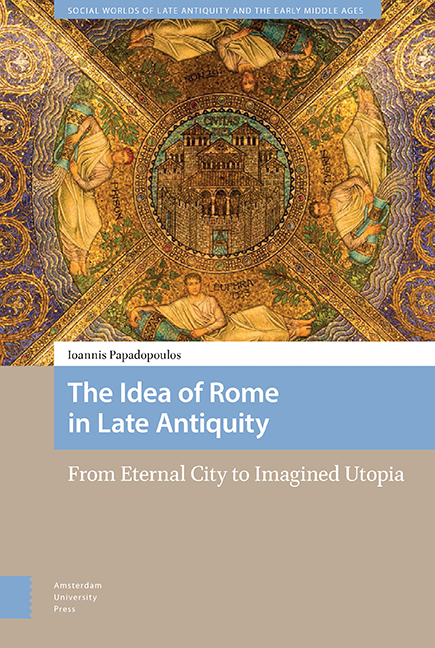Book contents
- Frontmatter
- Dedication
- Contents
- Introduction: Between a Physical and an Imaginary City
- I Looking Backwards: Ordo Renascendi
- II The Adventus of Constantius
- III Between Rome and Athens: The Artificial Romanitas of Julian
- IV Between the Altar and the Court: Symmachus and Claudian in Action
- V Between Christ and a Roman Place: The Emergence of Christian Rome in Time and Space
- VI Between Jerusalem and Babylon: The Archetype of Rome in the City of God
- Conclusions: From Rome to Eternity
- Bibliography
- Index
Conclusions: From Rome to Eternity
Published online by Cambridge University Press: 11 November 2021
- Frontmatter
- Dedication
- Contents
- Introduction: Between a Physical and an Imaginary City
- I Looking Backwards: Ordo Renascendi
- II The Adventus of Constantius
- III Between Rome and Athens: The Artificial Romanitas of Julian
- IV Between the Altar and the Court: Symmachus and Claudian in Action
- V Between Christ and a Roman Place: The Emergence of Christian Rome in Time and Space
- VI Between Jerusalem and Babylon: The Archetype of Rome in the City of God
- Conclusions: From Rome to Eternity
- Bibliography
- Index
Summary
Approaching the end of this book, we observe the patterns that characterized the reshaping of the idea of Rome in the period covered here. This evolution was neither linear, nor smooth but eventually secured the survival of Romanitas as a set of values, traditions, and behaviours in the turbulent world of the fifth and sixth centuries. Furthermore, the urban archetype of Utopia, as it was inherited from Classical thought, was deeply rooted in the city's landscape and nurtured Roman exceptionalism during the fourth century, indicating new ideological pathways and spiritual potentials.
The reflections of Rutilius Namatinaus during his journey to Gaul confirm the survival of Rome despite the Gothic sack. The rapid material recovery of the city and the atmosphere of optimism that the poet witnessed while leaving the city confirmed the eternity of Rome, which had been severely tested some years earlier (410). The antithesis between the urban Utopia (Rome) and the dystopian world (countryside) dominates the narrative. This snapshot of optimism, which was preserved in De Reditu Suo, was an alternative response to what Augustine preserved in his De Civitate Dei during the same period. Rutilius Namatianus still placed his hopes in the physical city and the decisive victory of Flavius Constantius over the Goths.
More than half a century earlier, in 357, the old capital was still seen as a neutral, symbolic landscape, at least this is what Ammianus Marcellinus says of Constantius's attitude to the old capital, which he approached like a museum visitor, a hidden gem in his Empire, of which he was previously totally unaware. The emperor's awkward style, however, revealed the systematic negligence that Rome had experienced for at least a century. This evident loss of touch with the core and cradle of the civilization that they were still living in was depressing and alarming, even to someone with a military background like Ammianus Marcellinus. Furthermore, the modus vivendi of the Nobilitas and the Populus Romanus was also a cause of concern for the Antiochene historian, who portrayed them as unworthy of their ancestral history and of their cultural legacy. At the same time, the attempt to equalize the Senate(s) of the Vetus and Nova Roma, which was promoted by the emperor and implemented by the arrival of the embassy of Themistius, created new circumstances.
- Type
- Chapter
- Information
- The Idea of Rome in Late AntiquityFrom Eternal City to Imagined Utopia, pp. 195 - 202Publisher: Amsterdam University PressPrint publication year: 2021



